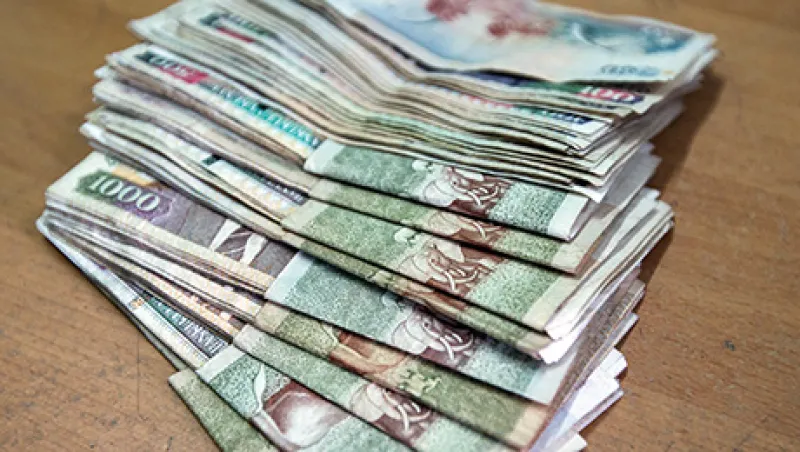What’s going on in Kenya may be a teething period, or it may be a study in unintended consequences. Regardless of the kind of uncertainty, the government is about to ask international investors to weigh in on a sovereign bond sale expected before July. Kenya plans to sell $1.5 billion in bonds and hopes that recent shakiness in the outlook for emerging markets and their debt instruments will not push yields too high. The common expectation is a range of about 8 to 10 percent. Road shows are expected to kick off this month.
The government voices hope, but on the street many simply go through their daily paces. As an illustrative case, last Thursday, March 27, during a session of Kenya’s legislature, the sidewalks along the road outside the Parliament building in Nairobi, which is long, boxy and bisected with a clock tower, were packed. Inside, President Uhuru Kenyatta, son of Kenya’s founding father and first president, Jomo Kenyatta, was wrapping up his state of the nation speech. Outside, metal gates separated the road from the sidewalk. The crowd grew seemingly in anticipation of a presidential motorcade passing by.
Just then, a man tried to cross the street through a gap in the gates. When a policeman turned toward him, another stepped onto the street. With the policeman caught between two jaywalkers, several others took a tentative step or two. A few seconds later, the trickle grew into a flood, as everyone on the north side of the road crossed to the south. The policeman waved a short baton in what looked like a halfhearted attempt at crowd control before giving up. As it turned out, these people were actually not waiting to catch a glimpse of their leader. They had simply found themselves delayed and bottled up by the traffic heading home after work. By the time the president’s motorcade of some 20 cars, sport-utility vehicles, trucks and motorcycles passed by, about half the original crowd was left watching.
Recent polling data echoes this turning away from Parliament, as public confidence in politicians both in the ruling and opposition parties has dropped. Kenya is implementing far-reaching economic reforms and struggling with their impact, headlined by the offloading of some government functions to 47 newly created counties. It’s hoped that this move will spread investment throughout Kenya, instead of concentrating it in the capital city of Nairobi. But for the moment, new bureaucracies — and therefore new opportunities for graft — characterize the Kenyan reality.
The Federal Reserve’s tapering of quantitative easing has generally tamped down demand for emerging-markets assets. But some institutional investors are wondering if it’s time for a secular shift into emerging-markets bonds anyway. Kenya certainly has its fans. In 2013 Kenya finished repaying the second of two loan packages from the International Monetary Fund that were extended after the violent aftermath of the 2007 election, which followed accusations of vote rigging and that eventually saw incumbent President Mwai Kibaki and opposition leader Raila Odinga both take office, the latter as prime minister, a post newly created under the postelection power-sharing agreement.
The IMF’s 2013 country report for Kenya reads like a fiscal love letter, praising almost all aspects of its macroeconomic management and inviting the country to return for another loan. Risks to the outlook include the devolution process, as the transfer of powers is called, and more generally concerns about public salaries, which are considered high in comparison to GDP. According to President Kenyatta, the Kenya government spends nearly $4.6 billion in salaries, an unsustainable proportion considering that that leaves only $2.3 billion for development initiatives.
Despite present worries, much about Kenya’s economy is ideal for buying long-term debt. The devolution plan is part of the 2010 constitutional reform, which has come with other positive developments, such as increased judicial transparency. For example, Willy Munyoki Mutunga, the chief justice of Kenya and president of Kenya’s Supreme Court, has recently submitted to media interviews, which strikes many Kenyans as a significant move toward transparency. The constitution has also protected government bureaucrats from being sacked. President Kenyatta has attempted to fire some high-ranking officials, although judicial stays have prevented him from doing so. Kenyatta is widely believed to be aiming to replace bureaucrats who present obstacles with those who are more business friendly, but the business community also appreciates the constraints on executive power.
Maturing institutions may also be reflected in Kenya’s macroeconomic data. The Kenya National Bureau of Statistics is working on a rebalancing and rebasing of gross domestic product. Kenya’s per capita GDP is $943 as of 2012, making it a low-income country, according to the World Bank’s classification system. That seems unusually low, particularly because Kenya is the only country in which mobile phone financial services have taken off. M-Pesa, a mobile money service launched in 2007 by Safaricom, the country’s dominant telecom, was originally intended as a system for making payments on microfinance loans. As of mid-2013, the system has more than 17 million users in the country. Roughly 25 percent of Kenya’s GDP circulates through the feature-phone-accessible? ?M-Pesa app. Data collectors suspect there is undercounting somewhere in the system, very likely in the informal economy.
Kenya’s recent oil finds also loom as a long-term factor. Whereas the government would like production to begin before the 2017 presidential elections, more time will likely be necessary. What is clear so far, however, is that Kenya’s estimated reserves will justify building a pipeline from the northern interior near the Great Rift Valley exploration zones to a coastal port at Mombasa. With oil production under way in neighboring South Sudan and soon in Uganda, Kenya could see an additional windfall from transmission fees and further cement its role as the leading economy in East Africa.
Besides being an oil-transport hub, Mombasa has potential to be a shipping port of choice for East Africa. Kenya wants to improve its Indian Ocean transportation modes and ports, which are in part a target for the upcoming bond sale. Another purpose is an upcoming balloon payment of $600 million on a syndicated loan arranged in 2012. A sovereign bond sale at that point might have gotten a lower yield, but devolution was an even bigger unknown than it is today and uncertainty loomed over 2012 elections. Kenya managed a smoother transfer of power after that vote, when the election result was contested in the courts instead of the streets.
President Kenyatta may still face charges at the International Criminal Court in the Hague for his alleged funding and abetting of the 2007 post-election violence. But for investors, that may not overshadow the feeling that after three election cycles into a democratic transition, Kenya looks to be mostly on the right track. Bond buyers may be an easier sell than Kenyans themselves, however, if the uninterested commuters passing by Parliament Thursday afternoon are any indication.






